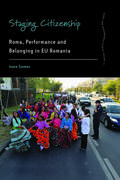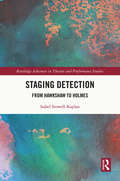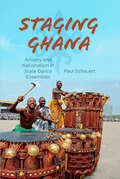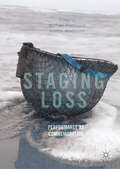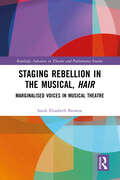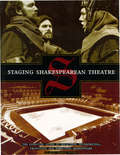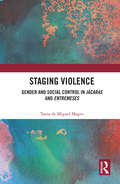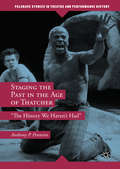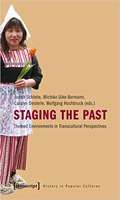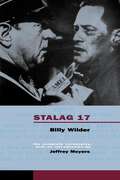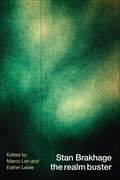- Table View
- List View
Staging Chinese Revolution: Theater, Film, and the Afterlives of Propaganda
by Xiaomei ChenStaging Chinese Revolution surveys fifty years of theatrical propaganda performances in China, revealing a dynamic, commercial capacity in works often dismissed as artifacts of censorship. Spanning the 1960s through the 2010s, Xiaomei Chen reads films, plays, operas, and television shows from an interdisciplinary and comparative perspective, demonstrating how, in a socialist state with "capitalist characteristics," propaganda performance turns biographies, memoirs, and war stories into mainstream ideological commodities, legitimizing the state and its right to rule. Analyzing propaganda performance also brings contradictions and inconsistencies to light that throw common understandings about propaganda's purpose into question.Chen focuses on revisionist histories that stage the lives of the "founding fathers" of the Communist Party, such as Chen Duxiu, Mao Zedong, and Deng Xiaoping, and the engaging mix of elite and ordinary characters that animate official propaganda in the private and public sphere. Taking the form of "personal" memories and representing star and youth culture and cyberspace, contemporary Chinese propaganda appeals through multiple perspectives, complicating relations among self, subject, agent, state building, and national identity. Chen treats Chinese performance as an extended form of political theater confronting critical issues of commemoration, nostalgia, state rituals, and contested history. It is through these reenactments that three generations of revolutionary leaders loom in extraordinary ways over Chinese politics and culture.
Staging Citizenship: Roma, Performance and Belonging in EU Romania (Dance and Performance Studies #11)
by Ioana SzemanBased on over a decade of fieldwork conducted with urban Roma, Staging Citizenship offers a powerful new perspective on one of the European Union’s most marginal and disenfranchised communities. Focusing on “performance” broadly conceived, it follows members of a squatter’s settlement in Transylvania as they navigate precarious circumstances in a postsocialist state. Through accounts of music and dance performances, media representations, activism, and interactions with both non-governmental organizations and state agencies, author Ioana Szeman grounds broad themes of political economy, citizenship, resistance, and neoliberalism in her subjects’ remarkably varied lives and experiences.
Staging Dance (Ballet, Dance, Opera And Music Ser.)
by Susan CooperStaging Dance is a practical handbook that covers all aspects of putting on a dance production. It highlights the current diversity of dance activities, choosing examples from working dance groups and from individual dancers.The book includes sections on choreography, music and sound, designing and making sets and costumes, lighting design and technical implementation and stage management. Funding, planning and publicity are also covered.Staging Dance will prove invaluable not only to dance artists, but also those working along side them: musicians, designers, lighting technicians, administrators and directors.
Staging Deaf and Hearing Theatre Productions: A Practical Guide
by Andy Head Jill Marie BradburyThis book explores an unacknowledged gap in theatre study and praxis, and establishes an inceptive model for transforming a playscript into a theatrical production involving deaf and hearing artists. The book stipulates that theatrical productions of this nature should strive to go beyond accessibility towards inclusivity by considering deaf perspectives at every stage of the process: When deaf actors are cast in roles assumed to be hearing, how does this change the world of the play? How does the inclusion of a visual language affect staging decisions? How can truly equal access to two different language modalities be achieved for diverse production teams and audiences? Because deaf artists should be involved in the leadership and creative decision making throughout the process, this book is co-written by a deaf and hearing team. The main topics of the book include pre-production preparation, the rehearsal process, and performance. As deaf theatre artists move increasingly into the foreground, it’s time for the hearing theatre world to learn how to undertake productions that successfully bridge the deaf and hearing worlds. By including the perspective of directors, actors, designers, and audience members, this guide lays out an ideal process towards achieving that goal.
Staging Detection: From Hawkshaw to Holmes (Routledge Advances in Theatre & Performance Studies)
by Isabel Stowell-KaplanStaging Detection reveals how the new figure of the stage detective emerged in nineteenth-century Britain. The first book to explore the productive intersections between detection and performance across a range of Victorian plays, Staging Detection foregrounds the role of the stage detective in shaping important theatrical modes of the period, from popular melodrama to society comedy. Beginning in 1863 with Tom Taylor’s blockbuster play, The Ticket-of-Leave Man, the book criss-crosses London following the earliest performances of stage detectives. Centring the work of playwrights, novelists, critics and actors, from Sarah Lane and Horace Wigan to Wilkie Collins and Oscar Wilde, Staging Detection sheds new light on Victorian acting styles, furthers our understanding of melodrama, and resituates the famous Wildean dandy as a successor to the stage detective. Drawing on histories of masculinity and gender performance as well as developing scientific theory and nineteenth-century visual culture, Staging Detection shows how the earliest stage portrayals of the detective shaped broader Victorian debates concerning fraud, omniscience and earned authority. This book will be of great interest to students and scholars of theatre history, Victorian literature and popular culture – as well as anyone with an interest in the figure of the detective.
Staging Ghana: Artistry And Nationalism In State Dance Ensembles (Ethnomusicology Multimedia)
by Paul SchauertThe Ghana Dance Ensemble takes Ghana's national culture and interprets it in performance using authentic dance forms adapted for local or foreign audiences. Often, says Paul Schauert, the aims of the ensemble and the aims of the individual performers work in opposition. Schauert discusses the history of the dance troupe and its role in Ghana's post-independence nation-building strategy and illustrates how the nation's culture makes its way onto the stage. He argues that as dancers negotiate the terrain of what is or is not authentic, they also find ways to express their personal aspirations, discovering, within the framework of nationalism or collective identity, that there is considerable room to reform national ideals through individual virtuosity.
Staging Interspaces in Contemporary British Theatre: Environment and Fluidity
by Vicky AngelakiThis open access book considers how relationships to place and spatial ecologies more broadly are becoming redefined in light of intersecting climate, health, identity and care crises. Through an interdisciplinary, intersectional discourse it investigates how spaces of liminality frame contemporary human conditions in their interactional modes with both human and non-human ecologies. The interspace grounds the discussion, indicating states of flux and transience, where the in-between is the defining characteristic. This open access monograph, then, takes up the new complexity in one’s relationship(s) to their surrounding spaces through a rigorous discussion of texts and performance contexts in cutting-edge contemporary British theatre on a national and international scale. It seeks to address how in-betweenness spatially, temporally, environmentally, geographically and socially conceived has been emerging as the primary state for the unmoored individual of our time – and how it might serve as catalyst for performing one's agency in modes more empathetic not only to other humans, but, also, and equally, to the non-human world.
Staging Loss: Performance as Commemoration
by Andrew Westerside Michael PinchbeckThis book locates and critically theorises an emerging field of twenty-first century theatre practice concerned, either thematically, methodologically, or formally, with acts of commemoration and the commemorative. With notions of memorial, celebration, temporality and remembrance at its heart, and as a timely topic for debate, this book asks how theatre and performance intersects with commemorative acts or rituals in contemporary theatre and performance practice. It considers the (re)performance of history, commemoration as a form of, or performance of, ritual, performance as memorial, performance as eulogy and eulogy as performance. It asks where personal acts of remembrance merge with public or political acts of remembrance, where the boundary between the commemorative and the performative might lie, and how it might be blurred, broken or questioned. It explores how we might remake the past in the present, to consider not just how performance commemorates but how commemoration performs.
Staging Muslims in Britain: Playwriting, Performance, and Representation (Routledge Advances in Theatre & Performance Studies)
by Önder ÇakırtaşThis scholarly volume delves into the manner in which British Muslims articulate their cultural, social and religious identities through theatrical productions in 21st-century Britain and examines their portrayal within these performances.The study investigates the factors influencing the emergence and evolution of Islamic theatre in Britain, providing an in-depth analysis of plays by British playwrights of both Muslim and non-Muslim origins that have shaped the trajectory of British Islamic theatre from the late 20th century to the present. Önder Çakırtaş critically examines how British playwrights, predominantly of Muslim origin but also including some of non-Muslim origin, depict Muslim identity and culture from their unique perspectives, particularly in the context of post-9/11 society. Adopting a comprehensive approach to Islamic playwriting and performance, this book highlights the accomplishments and contributions of contemporary British playwrights, primarily from Muslim backgrounds.This study will be of significant interest to scholars and students in theatre studies, as well as related disciplines such as Islamic studies, sociology and political science.
Staging Rebellion in the Musical, Hair: Marginalised Voices in Musical Theatre (Routledge Advances in Theatre & Performance Studies)
by Sarah Elisabeth BrowneThis volume provides a comprehensive survey of the musical Hair and will offer critical analysis which focuses on giving voice to those who are historically considered to be on the margins of musical theatre history. Sarah Browne interrogates key scenes from the musical which will seek to identify the relationship between performance and the cultural moment. Whilst it is widely acknowledged that Hair is a product of the sixties counter-culture, this study will place the analysis in its socio-historical context to specifically reveal American values towards race, gender, and adolescence. In arguing that Hair is a rebellion against the established normative values of both American society and the art form of the musical itself, this book will suggest ways in which Hair can be considered utopian: not only as a utopian ‘text’ but in the practices and values it embodies, and the emotions it generates in its audiences. This book will be of great interest to scholars and students of music, musical theatre, popular music, American studies, film studies, gender studies, or African American studies.
Staging Restoration Comedy: The Royal Shakespeare Company, 1967-2019
by David RobertsSince its 1967 production of Vanbrugh’s The Relapse, the Royal Shakespeare Company has been the world’s leading producer of Restoration Comedies. This book is the first to document and critique the company’s history of engagement with that repertoire. It reviews the spaces in which productions have been performed, design principles, casting, voicing, textual adaptation, musical direction, actor perspectives, and the problems of how to confront, adopt or depart from received notions of Restoration style. It goes on to posit that, for all the RSC’s explorations of Restoration Comedy, the company has maintained the repertoire as a fringe interest played out in niche spaces, while recycling many of the assumptions it claims to challenge, and that what is needed is the writer-led intervention seen in RSC and National Theatre adaptations of French drama from the same period. Only then can Restoration Comedy begin to engage wider audiences in new sites of political, historical andcultural meaning.
Staging Science
by Martin WillisThis book considers scientific performances across two centuries, from the early nineteenth century to the present day. Performances include demonstrations of technologies, experiments that look like theatre, theatre that looks like science, tourist representations and natural history film-making. Its key aim is to open debate on how scientific activity, both historical and contemporary, might be understood in the context of performance studies and the imaginative acts required to stage engaging performances. Scientific performances have become increasingly of interest to historians of science, literature and science scholars, and in the field of science studies. As yet, however, no work has sought to examine a range of scientific performances with the aim of interrogating and illuminating the kinds of critical and theoretical practices that might be employed to engage with them. With scientific performance likely to become ever more central to scholarly study in the next few years this volume offer a timely, and early, intervention in the existing debates, and aims, too, to be a touchstone for future work.
Staging Sex: Best Practices, Tools, and Techniques for Theatrical Intimacy
by Chelsea PaceStaging Sex lays out a comprehensive, practical solution for staging intimacy, nudity, and sexual violence. This book takes theatre practitioners step-by-step through the best practices, tools, and techniques for crafting effective theatrical intimacy. After an overview of the challenges directors face when staging theatrical intimacy, Staging Sex offers practical solutions and exercises, provides a system for establishing and discussing boundaries, and suggests efficient and effective language for staging intimacy and sexual violence. It also addresses production and classroom specific concerns and provides guidance for creating a culture of consent in any company or department. Written for directors, choreographers, movement coaches, stage managers, production managers, professional actors, and students of acting courses, Staging Sex is an essential tool for theatre practitioners who encounter theatrical intimacy or instructional touch, whether in rehearsal or in the classroom.
Staging Shakespearean Theatre: The Essential Guide to Selecting, Interpreting, Producing and Directing Shakespe are
by Elaine NovakFrom auditions and rehearsals to publicity, this guide leads even inexperienced directors, producers, choreographers and actors through the complicated and sometimes fearsome task of staking Shakespeare. Comprehensive information is presented in a browsable format including historical background of the Elizabeth period, descriptions of major plays, a glossary of terms, suggestions for modern interpretations, step-by-step instruction for choreographing fight scenes, and a full treatment of Romeo & Juliet
Staging Violence: Gender and Social Control in Jácaras and Entremeses
by Tania de Miguel MagroStaging Violence explores gender violence in Spanish early modern short theater. This book deals with domestic violence against women, extortion of prostitutes, and violence against men who display non-conventional forms of masculinity. The author argues that many "jácaras" and "entremeses" stage subversive discourses that repudiate or complicate official narratives of gender and the use of violence as a tool for achieving gender compliance. Short comic pieces are read against comedias. Each section of the book is expertly contextualized through an overview of the legal and moral contexts and the analysis of a variety of primary sources (law codes, manuals of conduct, church rulings, transcripts of civil and religious trials, and medical manuals) as well as statistical information. Staging Violence invites the reader to consider the transgressive potential of performance. As the first monograph entirely dedicated to the study of gender in this genre, this book is a vital resource for students and scholars interested in gender studies and theatre.
Staging Voice (Routledge Voice Studies)
by Michal Grover-FriedlanderStaging Voice is a unique approach to the aesthetics of voice and its staging in performance. This study reflects on what it would mean to take opera’s decisive attribute—voice—as the foundation of its staged performance. The book thinks of staging through the medium of voice. It is a nuances exploration, which brings together scholarly and directorial interpretations, and engages in detail with less frequently performed works of major and influential 20th-century artists—Erik Satie, Bertolt Brecht and Kurt Weill—as well as exposes readers to an innovative experimental work of Evelyn Ficarra and Valerie Whittington. The study is intertwined throughout with the author’s staging of the works accessible online. This book will be of great interest to students and scholars in voice studies, opera, music theatre, musicology, directing, performance studies, practice-based research, theatre, visual art, stage design, and cultural studies.
Staging a Comeback: Broadway, Hollywood, and the Disney Renaissance
by Peter C. KunzeIn the early 1980s, Walt Disney Productions was struggling, largely bolstered by the success of its theme parks. Within fifteen years, however, it had become one of the most powerful entertainment conglomerates in the world. Staging a Comeback: Broadway, Hollywood, and the Disney Renaissance argues that far from an executive feat, this impressive turnaround was accomplished in no small part by the storytellers recruited during this period. Drawing from archival research, interviews, and textual analysis, Peter C. Kunze examines how the hiring of theatrically trained talent into managerial and production positions reorganized the lagging animation division and revitalized its output. By Aladdin, it was clear that animation—not live action—was the center of a veritable “renaissance” at Disney, and the animated musicals driving this revival laid the groundwork for the company’s growth into Broadway theatrical production. The Disney Renaissance not only reinvigorated the Walt Disney Company but both reflects and influenced changes in Broadway and Hollywood more broadly.
Staging the Past in the Age of Thatcher: The History We Haven't Had (Palgrave Studies In Theatre And Performance History Ser.)
by Anthony P. PenninoThis book investigates how the British theatrical community offered an alternative and oppositional historical narrative to the heritage culture promulgated by the Thatcher and Major Governments in the 1980s and early 1990s. It details the challenges the theatre faced, especially reductions in government funding, and examines seminal playwrights of the period – including but not limited to Caryl Churchill, Howard Brenton, Sarah Daniels, David Edgar, and Brian Friel – who dramatized a more inclusive vision of history that gave voice to traditionally marginalized communities. It employs James Baldwin’s concept of witnessing as the means by which history could be deployed to articulate an alternative and emergent political narrative: “the history we haven’t had”. This book will appeal to students and scholars of theatre and cultural studies as well as theatre practitioners and enthusiasts.
Staging the Past: Themed Environments In Transcultural Perspectives (History In Popular Cultures)
by Judith Schlehe Michiko Uike-Bormann Carolyn Oesterle Wolfgang HochbruckPopular representations of history are taking on new forms and reaching wider audiences. The search for usable pasts is branching out into active appropriations of history such as historical theme parks, housing developments, and live-action role play. Drawing on themed environments across the continents, the articles in this volume focus on how these appropriations bypass, are different from, or even contradict traditional as well as scientific modes of disseminating historical knowledge. Bringing together theorists and practitioners, they provide the basis for an interdisciplinary as well as a transcultural theory of how pasts are staged in various social contexts.
Staging the Personal: A Guide to Safe and Ethical Practice
by Clark BaimThis book examines the history, ethics, and intentions of staging personal stories and offers theatre makers detailed guidance and a practical model to support safe, ethical practice. Contemporary theatre has crossed boldly into therapeutic terrain and is now the site of radical self-exposure. Performances that would once have seemed shockingly personal and exposing have become commonplace, as people reveal their personal stories to audiences with ever-increasing candor. This has prompted the need for a robust and pragmatic framework for safe, ethical practice in mainstream and applied theatre. In order to promote a wider range of ethical risk-taking where practitioners negotiate blurred boundaries in safe and artistically creative ways, this book draws on relevant theory and practice from theatre and performance studies, psychodrama and attachment narrative therapy and provides detailed guidance supporting best practice in the theatre of personal stories. The guidance is structured within a four-part framework focused on history, ethics, praxis, and intentions. This includes a newly developed model for safe practice, called the Drama Spiral.The book is for theatre makers in mainstream and applied theatre, educators, students, researchers, drama therapists, psychodramatists, autobiographical performers, and the people who support them.
Stalag 17
by Billy WilderStalag 17 (1953), the riveting drama of a German prisoner-of-war camp, was adapted from the Broadway play directed by José Ferrer in 1951. Billy Wilder developed the play and made the film version more interesting in every way. Edwin Blum, a veteran screenwriter and friend of Wilder's, collaborated on the screenplay but found working with Wilder an agonizing experience.Wilder's mordant humor and misanthropy percolate throughout this bitter story of egoism, class conflict, and betrayal. As in a well-constructed murder mystery, the incriminating evidence points to the wrong man. Jeffrey Meyers's introduction enriches the reading of Stalag 17 by including comparisons with the Broadway production and the reasons for Wilder's changes.
Stalebread Charlie and the Razzy Dazzy Spasm Band
by Michael MahinBased on a true story, a vibrant, inspirational picture book about self-reliance and the power of creativity and music, in which a group of hungry homeless kids in 19th century New Orleans build their own musical instruments from discarded items and become a successful band. It's 1895, and ten-year-old Stalebread Charlie and his friend Warm Gravy roam the streets of New Orleans, homeless and hungry. Stalebread has heard folks say that music feeds the soul—and he wonders if it could also fill their bellies. Soon he and his friends are playing instruments made out of junk—a fiddle from a cigar box, a kazoo from a comb—until their hats are filled with coins, their bellies are filled with beignets, and their souls are filled with music. This inspiring make-lemonade-from-lemons tale includes author/illustrator notes about the real Stalebread and the research behind the book and a make-your-own-instrument activity.
Stalin's Final Films: Cinema, Socialist Realism, and Soviet Postwar Reality, 1945-1953
by Claire KnightStalin's Final Films explores a neglected period in the history of Soviet cinema, breathing new life into a body of films long considered moribund as the pinnacle of Stalinism. While film censorship reached its apogee in this period and fewer films were made, film attendance also peaked as Soviet audiences voted with their seats and distinguished a clearly popular postwar cinema. Claire Knight examines the tensions between official ideology and audience engagement, and between education and entertainment, inherent in these popular films, as well as the financial considerations that shaped and constrained them. She explores how the Soviet regime used films to address the major challenges faced by the USSR after the Great Patriotic War (World War II), showing how war dramas, spy thrillers, Stalin epics, and rural comedies alike were mobilized to consolidate an official narrative of the war, reestablish Stalinist orthodoxy, and dramatize the rebuilding of socialist society. Yet, Knight also highlights how these same films were used by filmmakers more experimentally, exploring a diverse range of responses to the ideological crisis that lay at the heart of Soviet postwar culture, as a victorious people were denied the fruits of their sacrificial labor. After the war, new heroes were demanded by both the regime and Soviet audiences, and filmmakers sought to provide them, with at times surprising results. Stalin's Final Films mines Soviet cinema as an invaluable resource for understanding the unique character of postwar Stalinism and the cinema of the most repressive era in Soviet history.
Stan Brakhage the realm buster
by Marco Lori and Esther LeslieStan Brakhage's body of work counts as one of the most important within post-war avant-garde cinema, and yet it has rarely been given the attention it deserves. Over the years, though, diverse and original reflections have developed, distancing his figure little by little from critical categories. This collection of newly commissioned essays, plus some important reprinted work, queries some of the consensus on Brakhage's films. In particular, many of these essays revolve around the controversial issues of representation and perception.This project sets out from the assumption that Brakhage's art is articulated primarily through opposing tensions, which donate his figure and films an extraordinary depth, even as they evince fleetingness, elusivity and paradoxicality. This collection aims not only to clarify aspects of Brakhage's art, but also to show how his work is involved in a constant mediation between antinomies and opposites. At the same time, his art presents a multifaceted object endlessly posing new questions to the viewer, for which no point of entry or perspective is preferred in respect to the others. Acknowledging this, this volume hopes that the experience of his films will be revitalised.Featuring topics as diverse as the technical and semantic ambiguity of blacks, the fissures in mimetic representation of the 'it' within the 'itself' of an image, the film-maker as practical psychologist through cognitive theories, the critique of ocularcentrism by mingling sight with other senses such as touch, films that can actually philosophise in a Wittgensteinian way, political guilt and collusion in aesthetic forms, a disjunctive, reflexive, and phenomenological temporality realising Deleuze's image-time, and the echoes of Ezra Pound and pneumophantasmology in the quest of art as spiritual revelation; this book addresses not only scholars, but also is a thorough and thought-provoking introduction for the uninitiated. Contributors include: Nicky Hamlyn, Peter Mudie, Paul Taberham, Gareth Evans, Rebecca A. Sheehan, Christina Chalmers, Stephen Mooney and Marco Lori.
Stan Brakhage: Interviews (Conversations with Filmmakers Series)
by Suranjan GangulyIn this volume, editor Suranjan Ganguly collects nine of Stan Brakhage’s most important interviews in which the filmmaker describes his conceptual frameworks; his theories of vision and sound; the importance of poetry, music, and the visual arts in relation to his work; his concept of the muse; and the key influences on his art-making. In doing so, Brakhage (1933–2003) discusses some of his iconic films, such as Anticipation of the Night, Dog Star Man, Scenes from Under Childhood, Mothlight, and The Text of Light.One of the most innovative filmmakers in the history of experimental cinema, Brakhage made almost 350 films in his fifty-two-year-long career. These films include psychodramas, autobiography, Freudian trance films, birth films, song cycles, meditations on light, and hand-painted films, which range from nine seconds to over four hours in duration. Born in Kansas City, Missouri, he lived most of his life in the mountains of Colorado, teaching for twenty-one years in the film studies program at the University of Colorado, Boulder.As a filmmaker, Brakhage’s life-long obsession with what he called an “adventure in perception” made him focus on the act of seeing itself, which he tried to capture on film in multiple ways both with and without his camera and by scratching and painting on film. Convinced that there is a primary level of cognition that precedes language, he wrote of the “untutored eye” with which children can access ineffable visual realities. Adults, who have lost such primal sight, can “retrain” their eyes by becoming conscious of what constitutes true vision and the different ways in which they daily perceive the world. Brakhage’s films experiment with such perceptions, manipulating visual and auditory experience in ways that continue to influence film today.

